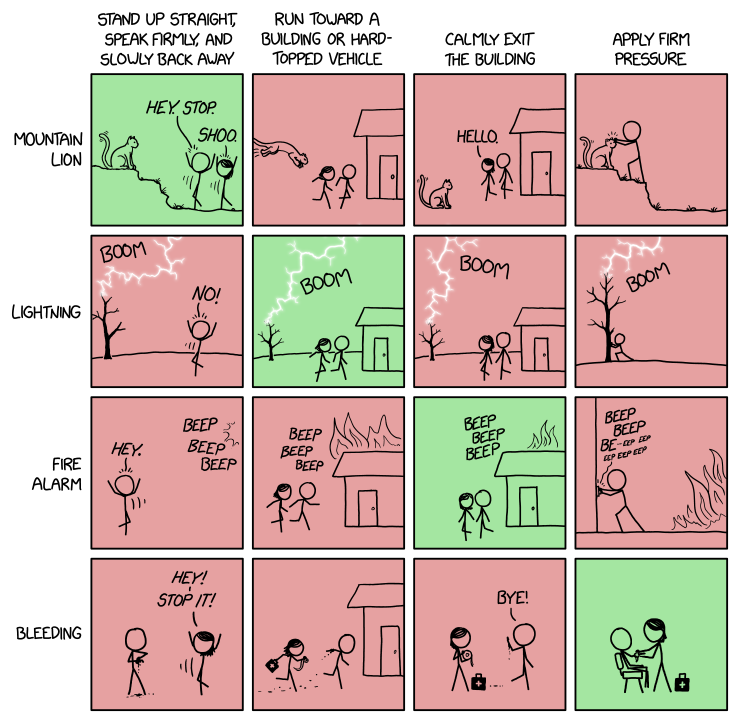What to Do

FYI: The 'drop, cover, and hold on' advice only applies to earthquakes. If you encounter a mountain lion, you should absolutely not drop to the ground, crawl under it, and hold on to one of its legs.

FYI: The 'drop, cover, and hold on' advice only applies to earthquakes. If you encounter a mountain lion, you should absolutely not drop to the ground, crawl under it, and hold on to one of its legs.
Similar to 1890: What to Bring, this comic takes four unrelated dangerous situations (mountain lion sighting, nearby lightning, fire alarm, and bleeding), and tries to mix-and-match the solutions. Predictably, mixing up good advice leads to fairly nonsensical behavior, so only the original four matches are marked green as acceptable. This comic is also similar, to a lesser extent, to Appliances.
The title-text introduces another disaster, an earthquake, into the mix-and-match. A common safety precaution during an earthquake is to drop, cover, and hold on, which helps prevent you from being thrown about and/or hit by debris. However, attempting to "drop, cover, and hold on" in response to a mountain lion sighting is more likely to get you into danger than out of it.
- Advice
(problem) vs (solution) Stand Up Straight, Speak Firmly, and Slowly Back Away Run Toward a Building or Hard-Topped Vehicle Calmly Exit the Building Apply Firm Pressure mountain lion This is a common recommendation when encountering a mountain lion (puma, cougar, etc) out in nature. One should continue to face the mountain lion because mountain lions like clawing victims in the back of the neck and because facing away means that you can't try to kick the mountain lion in the face if they charge at you. Running away may cause the animal to chase you, and they may consider you as prey. If you safely make it into a building or vehicle, you may be able to hide or drive away from the animal and may be safer than being outdoors with them; however, it is safer to approach said building or vehicle slowly, so as to not provoke the animal. Exiting a building and approaching the animal is not a good idea. If the animal is inside the building, however, it is recommended to combine this advice with (1). Applying "firm pressure" to the (wild) animal is a terrible idea and may result in injury or death, mainly because one has to be close to them in order to touch the,. Applying light pressure to a domesticated cat may make them less likely to attack, but wild cats do not respond positively to it. lightning Yelling at lightning is ineffective. Also, making yourself stand more erect to maximize your apparent height and backing away slowly from a lightning strike will make you more of a target as you will then become more prominent above the surrounding terrain. This is the recommended solution when encountering lightning - to go indoors or inside of a hard-topped vehicle to avoid being struck. Either of these options will function as a rudimentary Faraday cage if lightning does strike your location, taking the brunt of the lightning and directing the charge away from the vulnerable humans inside. (Contrary to popular belief, a car's rubber tires offer no protection from lightning, compared to the body of the car itself) Exiting a building is a poor idea, as the risk of getting struck by lightning is increased, as are the chances of being caught in any associated rainstorm or fulminogenic fire. There is no safe way to "apply firm pressure" to lightning. In the diagram, Cueball applies pressure to the tree, which is just about the worst possible thing to do in a storm, as when lightning strikes the tree the electric charge will pass through Cueball, not to mention the associated risk of the tree exploding or a limb detaching and falling on him. fire alarm Yelling at a fire alarm is ineffective. [citation needed] When a fire alarm is sounding, it is terrible advice to run towards the sound of the alarm, unless you are a trained fire fighter with suitable tools. If, however, you happen to be the cause of the fire, running towards a vehicle is completely understandable. This is the recommended advice when hearing a fire alarm - to calmly exit the building, and move to a safe location. Applying firm pressure to a fire alarm will not result in stopping the alarm, unless you are able to damage the device, suppress the sound (either by covering the noisemaker or by pressing the alarm's button to temporarily silence it), or block the fire alarm sensors. Regardless, this will not stop the actual fire. Also, there is no safe way to "apply firm pressure" to fire, unless applying firm pressure is interpreted as using a fire blanket. bleeding Yelling at a bleeding wound is ineffective. Yelling at a bleeding person may make them feel worse. Running toward a building or vehicle is not a typical solution if someone is bleeding, and the increase in heart rate from running may make the injury bleed more quickly. However, there could be medical supplies and/or medically trained people (nurses, doctors, paramedics, etc.) inside the building or vehicle, so this idea is not completely incorrect. Exiting a building is not helpful if someone is bleeding, if either the exiting one is the injured one, or the non-injured one. Although, if someone/something in the building (such as a mountain lion) is the cause of the bleeding, this could be a good idea so that the bleeding or injury does not get worse. This is the recommended solution to stop bleeding - apply firm pressure to staunch the bleeding, using some kind of absorbent material (cloth bandages are the gold standard, but any clean fabric (such as clothing, towels, sheets etc.) will suffice), or, if you are trained in first-aid and the bleeding is particularly heavy, applying a tourniquet around the limb above the wound.